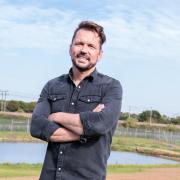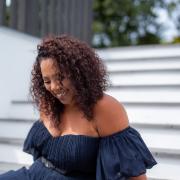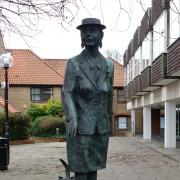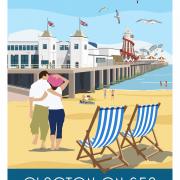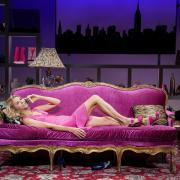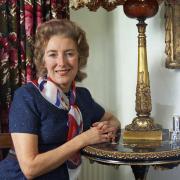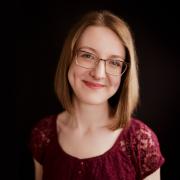What does it mean to be black in Essex? Southend-based British African-Caribbean artist, producer and activist Elsa James is exploring this experience in the misunderstood and homogeneously white county that she calls home
Wearing a T-shirt emblazoned with the words ‘This is what an Essex girl looks like’ while wandering around the Women of the World Festival (WOW) at London’s Southbank Centre two years ago prompted Elsa James to have some interesting conversations with passers-by.
‘Here I was, a black woman, walking around London announcing to all “I am an Essex girl” and yet, I was embarrassed,’ explains Elsa, who moved to Thurrock from west London in 1999 and then settled with her family in Southend in 2009. ‘I was ashamed to tell people I lived in Essex, especially black folks in London, who would look at me as if something might be seriously wrong with my decision to live here.’

Just a few months before, Elsa had embarked on her first solo project since leaving Chelsea College of Arts, a work responding to stories of black presence in Britain prior to the arrival of the Empire Windrush in 1948. Alongside a historian specialising in black British history, she created two short films about two black women who spent time in Essex – one in Harlow during the 1700s and the other in Southend in 1908.
‘Their stories profoundly resonated with me,’ she says, but what astonished Elsa most was that records of these stories sat gathering dust in our national archives. ‘They seemed to me to be overlooked or simply not recognised as significant.’ Elsa’s films, Forgotten Black Essex, made their debut at Southend’s Chalkwell Hall in February 2018.
‘They were a homage to two extraordinary black women who were indeed part of the history of Essex,’ Elsa continues. ‘So, taking that into account, and the numerous conversations with WOW Festival-goers about the ridiculousness of the stereotyping of Essex people, I sat down and took stock of my predicament and decided to make something positive, liberating and proud about being a black woman in Essex.

‘I coined the term Black Girl Essex.’
Elsa intended to play with the stereotype of the Essex Girl, a cliched characterisation of women from Essex as unintelligent, promiscuous and materialistic.
‘However, as this is a historically white stereotype, the idea of prefixing Essex with “black” seemed like a radical declaration that I also felt compelled to unpack and explore,’ expands Elsa.
One of the first people Elsa tried out the new term on was her eldest daughter, at the time aged 23. Her reaction was quite unexpected.
‘She revealed to me several traumatic stories of her experience during her teens, juxtaposing her black identity with white Essex,’ remembers Elsa. ‘One was the time when her cousin told her that his white girlfriend, with whom he lived in London, was “blacker” than she was because she was growing up as an Essex girl. I was totally unaware of my own daughter’s identity crisis. How could it be that a county could have such a strong impact on a young person’s identity? Was Essex diluting her black identity?’

Elsa began to widen her exploration of the experiences of black people of all ages in Essex during a four-month residency titled Black Girl Essex, funded by the Arts Council, at Colchester’s Firstsite gallery last summer. In an area of the gallery called the Living Room, which she furnished with photographs, sculptures and artefacts from the homes of people of African-Caribbean heritage, she hosted a series of discussions with members of Essex’s black community that encouraged them to consider and articulate the realities of living in the county.
As well as the Forgotten Black Essex films, the Living Room also screened two seminal films from Elsa’s portfolio of work – 150 Lies Myths and Truths and Goat Curry and Rap. 150 Lies Myths and Truths, made in 2006, is an 18-minute film in response to a pregnancy scan confirming Elsa was expecting another girl and her thoughts about the multitude of ‘labels’ that exist in the world, both historical and contemporary, for black girls and women.
150 adjectives are projected onto Elsa’s pregnant tummy describing everyday racial and pejorative epithets that black people have been humiliated by in the centuries of slavery and later colonial administration.
Meanwhile, Goat Curry and Rap, from 2010, is an eight-minute film made in response to comments from Rod Liddle in the press. Liddle wrote ‘…we have rap music, goat curry and a far more vibrant and diverse understanding of cultures, which were once alien to us. For which, many thanks’.
In her film, Elsa humanises these stereotypes in a performative manner, by eating a large bowl of curried goat to the soundtrack of blaring British rap music, with a direct and unflinching stare into the camera throughout.
Sound bites from the Firstsite discussions gave rise to a new film that Elsa titled Black Girl Essex: Here We Come, Look We Here, which she filmed at Tilbury Docks, where the HMT Empire Windrush docked carrying over 500 migrants from the Caribbean in 1948. She also made a new appliqué flag – The Black Essex Flag, a replica of the county flag but made using black leather, black satins and metallic materials on a black field.
‘The film and the flag are an act of “taking up space”, and for black voices in Essex to be heard,’ she says, ‘as they have never been part of the Essex narrative from both inside or outside of the county.’
Both were shown in a second exhibition at Firstsite, titled Super Black, in the winter of 2019–20 that asked, ‘What does it mean to be black in England today?’ This included artwork from the Arts Council Collection, which is the most widely circulated national loan collection of modern and contemporary British art by black artists including Hurvin Anderson, Claudette Johnson, Vanley Burke, Sonia Boyce and Helen Cammock.
Much to Elsa’s delight, the original recordings of her discussions at Firstsite with black Essex residents have been preserved in the digital sound archives at the Essex Record Office, and since then she has been working to further delve into what she describes as, ‘the historical, temporal and spatial dimensions of what it means to be black in Essex’.
This August, Elsa was artist-in-residence for Metal Southend Remote Residencies, which gave her another great opportunity to begin gathering new insights for developing and creating future work.
‘I want to strengthen and equip my practice with data, statistics and trends, facts and myths, both historical and contemporary, regarding the county of Essex,’ says Elsa. ‘The month-long residency is just the beginning of this exploration.’
Elsa spent some of her residency talking to Essex author and friend Syd Moore, best known for her Essex Witch Museum Mystery book series. As more women were executed in Essex than in any other county in the UK, Elsa is looking forward to researching the witch persecutions of Essex further.
‘I really think there might be a possibility that one of these women may have been black or mixed-raced,’ she says.
She was also intrigued to discover that Basildon recently lost its top spot as the place in Britain where fake tan is used the most (to Liverpool).
‘This idea of making white skin brown from a tube has got me thinking about making a public performance artwork involving myself, the town square and fake tan,’ hints Elsa. ‘Centring the county of Essex, the place I have lived in for the last two decades but only recently embraced as my home, has never felt more profound than in this moment.’
Forgotten Black Essex is showing at the Beecroft Gallery in Southend as part of the exhibition This is What an Essex Girl Looks Like until October 17, 2020 (unfortunately, the gallery is temporarily closed due to Covid-19. Check the gallery website for the latest opening information). For more of Elsa’s work, see elsajames.com
____________
Follow Essex Life on Facebook, Twitter and Instagram
SUBSCRIBE to Essex Life magazine for history, food and drink, walks, the latest events and more
____________




